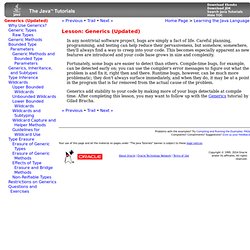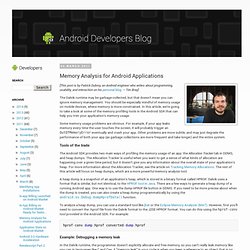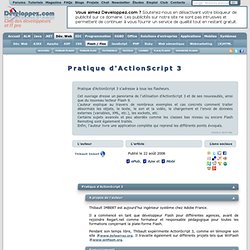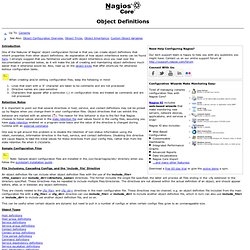

Lesson: Generics (Updated) (The Java™ Tutorials > Learning the Java Language) In any nontrivial software project, bugs are simply a fact of life.

Careful planning, programming, and testing can help reduce their pervasiveness, but somehow, somewhere, they'll always find a way to creep into your code. This becomes especially apparent as new features are introduced and your code base grows in size and complexity. Memory Analysis for Android Applications. [This post is by Patrick Dubroy, an Android engineer who writes about programming, usability, and interaction on his personal blog. — Tim Bray] The Dalvik runtime may be garbage-collected, but that doesn't mean you can ignore memory management.

You should be especially mindful of memory usage on mobile devices, where memory is more constrained. In this article, we're going to take a look at some of the memory profiling tools in the Android SDK that can help you trim your application's memory usage. Some memory usage problems are obvious. For example, if your app leaks memory every time the user touches the screen, it will probably trigger an OutOfMemoryError eventually and crash your app. Tools of the trade The Android SDK provides two main ways of profiling the memory usage of an app: the Allocation Tracker tab in DDMS, and heap dumps.
Gc in android. Android Tutorial Java-Garbage Collector(Part-3) Coursera. GC Android. Java SE 6 HotSpot[tm] Virtual Machine Garbage Collection Tuning. Note: For Java SE 8, see Java Platform, Standard Edition HotSpot Virtual Machine Garbage Collection Tuning Guide.
![Java SE 6 HotSpot[tm] Virtual Machine Garbage Collection Tuning](http://cdn.pearltrees.com/s/pic/th/hotspot-virtual-collection-18898734)
The Java™ Platform, Standard Edition (Java SE™) is used for a wide variety of applications, from small applets on desktops to web services on large servers. In support of this diverse range of deployments, the Java HotSpot™ virtual machine implementation (Java HotSpot™ VM) provides multiple garbage collectors, each designed to satisfy different requirements. Java - Why is it a bad practice to call System.gc. Tuning Garbage Collection with the 5.0 Java[tm] Virtual Machine. Introduction The Java TM 2 Platform Standard Edition (J2SE TM platform) is used for a wide variety of applications from small applets on desktops to web services on large servers.
![Tuning Garbage Collection with the 5.0 Java[tm] Virtual Machine](http://cdn.pearltrees.com/s/pic/th/garbage-collection-virtual-5982214)
In the J2SE platform version 1.4.2 there were four garbage collectors from which to choose but without an explicit choice by the user the serial garbage collector was always chosen. In version 5.0 the choice of the collector is based on the class of the machine on which the application is started. This “smarter choice” of the garbage collector is generally better but is not always the best. How Garbage Collection works in Java.
Scripts. Crontab. Unix systems start up the cron daemon in multi-user mode.

Hence, so does Linux. The cron daemon will execute programs at predestined times. The daemon wakes up every minute and runs the commands as necessary. Files in which the time and interval to run commands are specified, as well as the commands themselves, are called crontab files. All cron implementations support user crontabs: each system-user has his/her own cron command file. By default, either only the superuser or every user will have the right to create and maintain a crontab file (which of the two depends on the local configuration).
The information in user files is often stored in memory by the daemon - therefore, when you change the user files manually, by editing them, you will need to restart the cron daemon to activate the changes. . $ crontab -e to edit your personal entry. Alternately, you can use a file in your HOME directory (or another location where you have write-access) and edit this file. Adobe Flex 3 Component Life Cycle. Pratique d'ActionScript 3. Pratique d'ActionScript 3 s'adresse à tous les flasheurs.

Cet ouvrage dresse un panorama de l'utilisation d'ActionScript 3 et de ses nouveautés, ainsi que du nouveau lecteur Flash 9. L'auteur explique au travers de nombreux exemples et cas concrets comment traiter désormais les objets, le texte, le son et la vidéo, le chargement et l'envoi de données externes (variables, XML, etc.), les sockets, etc. Certains sujets avancés et peu abordés comme les classes bas niveau ou encore Flash Remoting sont également traités.
Enfin, l'auteur livre une application complète qui reprend les différents points évoqués. Article lu 5644 fois. A propos de l'auteur▲ Thibault IMBERT est aujourd'hui ingénieur système chez Adobe France. Il a commencé en tant que développeur Flash pour différentes agences, avant de rejoindre Regart.net comme formateur et responsable pédagogique pour toutes les formations conçernant la plate-forme Flash. Object Definitions. Introduction One of the features of Nagios' object configuration format is that you can create object definitions that inherit properties from other object definitions.

An explanation of how object inheritence works can be found here. I strongly suggest that you familiarize yourself with object inheritence once you read over the documentation presented below, as it will make the job of creating and maintaining object definitions much easier than it otherwise would be. Also, read up on the object tricks that offer shortcuts for otherwise tedious configuration tasks. When creating and/or editing configuration files, keep the following in mind: Lines that start with a '#' character are taken to be comments and are not processed Directive names are case-sensitive Characters that appear after a semicolon (;) in configuration lines are treated as comments and are not processed.
Maven. Java.
Java Tutorials. Java Dev.